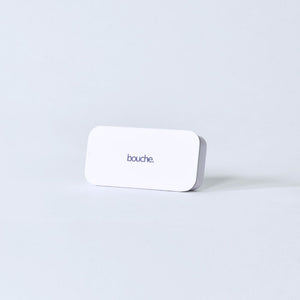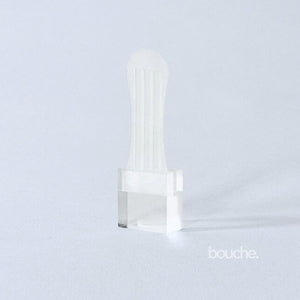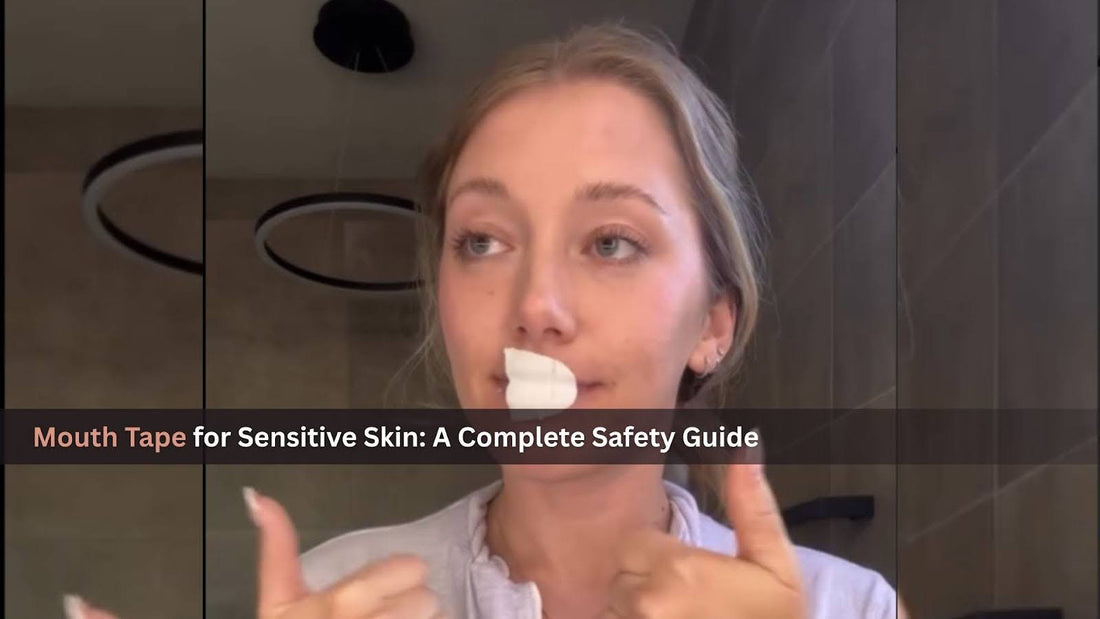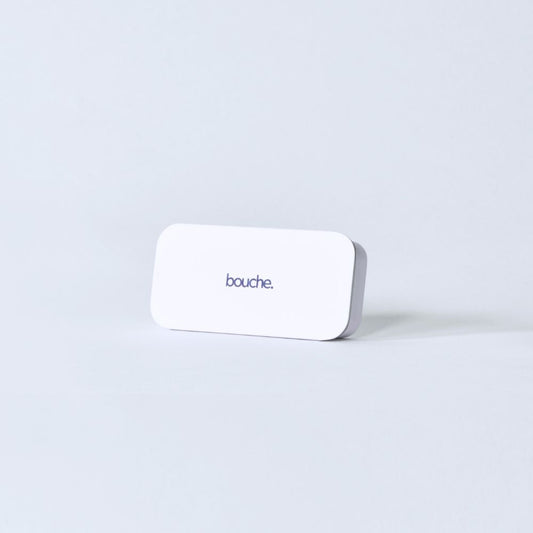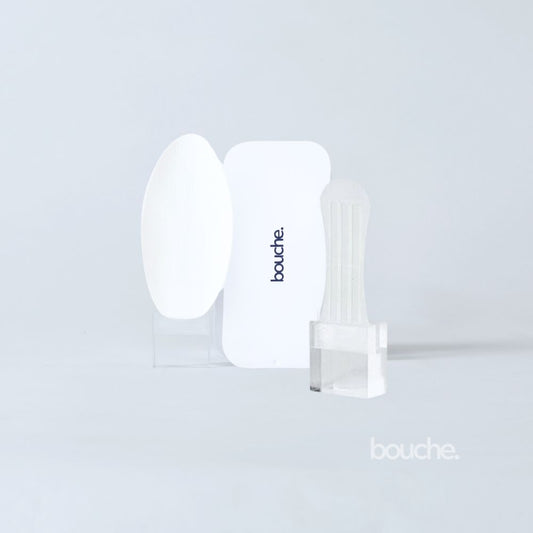If you consistently wake up feeling as tired as when you went to bed, the way you breathe at night might be the problem. Many of us unknowingly breathe through our mouths during sleep, a habit that can lead to snoring, dry mouth, and lower-quality rest. Mouth taping involves placing a specially designed strip of tape over your lips at bedtime to encourage the body's natural and more efficient state: nasal breathing. If you have delicate skin, the idea of applying an adhesive to your face might give you pause. However, with the right approach and a high-quality mouth tape for sensitive skin, you can safely adopt this practice to unlock more restorative sleep.
Here, we'll cover everything you need to know about skin-safe mouth taping, from its benefits to the best practices for application.
What is Mouth Tape and How Does It Work?
Mouth taping is the practice of placing a small, specially designed strip of tape over your lips before you go to sleep. The goal is straightforward: to encourage your body to breathe through the nose instead of the mouth.
Understanding the Concept of Mouth Taping
Our bodies are designed for nasal breathing. The nose acts as a natural filter, warming, humidifying, and cleaning the air we inhale. It traps allergens and pollutants, and the process of nasal breathing increases oxygen uptake and circulation. When we breathe through our mouths during sleep, we bypass this intricate natural filtration system. Mouth taping gently holds the lips together, making nasal breathing the path of least resistance and helping to retrain your body’s natural breathing patterns over time.
Common Reasons for Mouth Taping
People are trying mouth taping for several key reasons, all pointing toward better health. The most common motivations include:
- Reducing or eliminating snoring
- Improving overall sleep quality
- Enhancing dental health by preventing dry mouth
- Boosting cognitive function and daytime focus
- Supporting better facial structure and jawline definition through proper breathing patterns.
The Upside of Using Mouth Tape for Sensitive Skin
While the primary goal of mouth taping is to promote nasal breathing, the benefits extend far beyond that, especially when using tape designed for sensitive complexions.
How Mouth Tape Can Improve Your Sleep
By encouraging nasal breathing, mouth taping can transform your sleep. Nasal breathing is more stable and efficient, which can lead to deeper, more restorative sleep cycles. It helps maintain optimal oxygen levels throughout the night, which means you're more likely to wake up feeling refreshed and energized rather than tired and groggy. For many, this simple change addresses issues like frequent waking, restless sleep, and even mild forms of sleep-disordered breathing.
Additional Perks for Those with Sensitive Skin
The benefits aren't just internal. Chronic mouth breathing can lead to a dry mouth and lips, which can cause irritation and chapping. By keeping the mouth closed, taping helps maintain natural moisture. Furthermore, the improved sleep and oxygenation from nasal breathing can contribute to overall skin health, potentially leading to a clearer, more vibrant complexion. Using a hypoallergenic mouth tape made from gentle materials ensures these benefits don't come at the cost of skin irritation.
Safety Concerns and Risks of Mouth Taping
While mouth taping is generally safe for most people, it's important to be aware of potential risks and to know when to exercise caution.
Potential Side Effects of Mouth Taping
The most common concern, especially for those with delicate skin, is irritation from the adhesive. Using standard tapes not designed for skin can cause redness, rashes, or even breakouts. This is why choosing a high-quality, medical-grade oral tape for sensitive skin is crucial. Some people may also feel a bit anxious or claustrophobic at first, though this usually subsides as they get used to the sensation.
Who Should Avoid Mouth Taping?
Mouth taping is not for everyone. You should avoid it or speak with a healthcare professional first if you:
- Have difficulty breathing through your nose due to chronic congestion, allergies, or a deviated septum.
- Suffer from diagnosed or suspected severe obstructive sleep apnea, as it could restrict airflow in some cases.
- Are feeling sick, especially with a cold or sinus infection that blocks your nasal passages.
- Have consumed alcohol or sedatives, which can relax your airways and make breathing more difficult.
Always consult your doctor before trying mouth taping if you have any underlying health conditions, especially respiratory or sleep-related issues.
Preparing Your Skin for Mouth Tape
Proper preparation is the key to a comfortable and irritation-free experience. Taking a few extra moments to prep your skin can make all the difference.
Tips for Minimizing Skin Irritation
To ensure the tape is effective without causing a reaction, follow these simple steps. This is a crucial part of any hypoallergenic mouth tape guide.
- Clean and Dry: Start by washing your face to remove any oils, makeup, or moisturizers from the area around your mouth. Pat the skin completely dry.
- Create a Barrier: If your skin is particularly sensitive, apply a very thin layer of a non-comedogenic moisturizer or lip balm around your lips. Allow it to fully absorb for about 10 minutes before applying the tape.
- Patch Test: Before your first full night, apply a small piece of the tape to an inconspicuous area, like your inner arm, for a few hours to check for any reaction.
Choosing the Right Mouth Tape for Sensitive Skin
The type of tape you use matters immensely. Never use household tapes like duct tape or packing tape. Instead, look for tapes with these features:
- Medical-Grade: Choose tapes specifically designed for use on human skin.
- Hypoallergenic: Opt for a tape labeled as hypoallergenic to minimize the risk of allergic reactions.
- Porous and Breathable: The material should allow air to pass through, preventing moisture buildup.
- Gentle Adhesive: The adhesive should be strong enough to hold but gentle enough for easy removal without pulling on the skin.
Specialized products, like Bouche's mouth tape for sensitive skin, are crafted with these exact needs in mind.
Best Practices for Safe Mouth Taping
Once you've chosen the right tape and prepped your skin, proper application will ensure you get the best results safely.
Proper Application Techniques
Applying the tape is simple. Most people prefer a single strip placed horizontally or vertically across the center of the lips. Some tapes come in specific shapes, like an 'X' or an 'H', which can feel less restrictive. Press the tape down gently, ensuring it's secure but not uncomfortably tight. The goal is to gently remind your lips to stay closed, not to seal them shut.
Monitoring and Precautions During Use
When you first start, pay attention to how you feel. If you wake up and feel like you can't breathe or experience significant discomfort, remove the tape immediately. It's normal to take a few nights to adjust. If you notice any persistent redness or rash where the tape was applied, discontinue use. A little mindfulness goes a long way in ensuring a positive experience.
Bouche: Science-Backed Tools for Better Breathing
At Bouche, we are dedicated to improving health through non-invasive tools that are backed by science. Our flagship product, a premium medical-grade mouth tape, is designed to support nasal breathing for deeper sleep and enhanced vitality. We understand that comfort and safety are paramount, which is why our tape is manufactured in North America using hypoallergenic materials specifically chosen for sensitive skin. Bouche products, which are also CPAP compatible, are created to seamlessly fit into your nightly routine, restoring your body's natural processes so you can feel and perform your best.
Alternatives to Mouth Taping
If you find that mouth taping isn't right for you, there are other ways to encourage nasal breathing.
Other Methods to Encourage Nasal Breathing
Nasal strips, which are placed on the outside of your nose, can help open up your nasal passages. For a comprehensive solution, a Breathe Better Kit often combines mouth tape and nasal strips to support nasal breathing from multiple angles. Certain breathing exercises, like those taught in the Buteyko Method, can also help retrain your breathing patterns over time. Practicing conscious nasal breathing during the day can also help make it a more natural habit at night.
When to Consult a Healthcare Professional
If you consistently struggle with issues like loud snoring, daytime sleepiness, or waking up gasping for air, it's important to talk to your doctor. These can be signs of an underlying condition like sleep apnea that requires a proper diagnosis and treatment plan. A healthcare professional can help you get to the root of your sleep problems and find the safest, most effective solution for you.
Making Informed Choices About Mouth Taping
Deciding to try mouth taping is a personal choice, and it's one that should be made with good information and a focus on your own well-being.
Prioritize Your Safety and Comfort
Ultimately, the goal is to improve your health and sleep quality. Listen to your body, choose your products wisely, and don't hesitate to consult a professional if you have concerns. By prioritizing safety and comfort, you can determine if mouth taping is the right tool to help you prevent mouth breathing at night and achieve more restful sleep.
Recap of Key Points
Mouth taping is a simple practice that encourages nasal breathing, which can lead to better sleep, reduced snoring, and improved oral health. For those with sensitive skin, using a high-quality, hypoallergenic tape and following proper skin preparation techniques are the keys to avoiding irritation.
Frequently Asked Questions
Q: Is mouth tape safe for sensitive skin?
Yes, it can be very safe, provided you use a high-quality, medical-grade, hypoallergenic mouth tape designed specifically for this purpose. Always perform a patch test first and follow proper skin preparation to minimize any risk of irritation.
Q: How to patch test mouth tape on sensitive lips?
- Apply a small piece of the tape to a less sensitive area of your skin, like the inside of your wrist or arm.
- Leave it on for a few hours, then remove it gently and check for any signs of redness, itching, or irritation.
Q: Which adhesives are least likely to cause reactions?
Look for medical-grade, gel-like, or silicone-based adhesives that are labeled hypoallergenic and latex-free. These are formulated to be gentle on the skin and are less likely to trigger a tape allergy mouth reaction.
Q: How to remove tape without irritating skin?
Remove the tape slowly and gently. If it feels stuck, you can apply a bit of warm water or a natural oil (like coconut or jojoba oil) around the edges to help loosen the adhesive before peeling it off.
Q: What to do if mouth tape causes a rash?
If you develop a rash, redness, or itching, stop using the tape immediately. Clean the area with a gentle cleanser and apply a soothing, fragrance-free moisturizer. If the rash persists or worsens, consult a healthcare professional.
Also Read
- How Do Nasal Strips Work?
- Best Mouth Tape for Sleeping
- Top 5 Snore Tracking Apps
- 10 Natural Remedies to Stop Snoring
- How to Keep Your Mouth Closed While Sleeping
- How to Get Rid of a Double Chin
